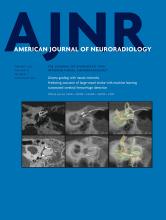Research ArticlePediatric Neuroimaging
Assessment of the Membranous Labyrinth in Infants Using a Heavily T2-weighted 3D FLAIR Sequence without Contrast Agent Administration
G. Conte, S. Casale, L. Caschera, F.M. Lo Russo, C. Paolella, C. Cinnante, F. Di Berardino, D. Zanetti, D. Stocchetti, E. Scola, L. Bassi and F. Triulzi
American Journal of Neuroradiology February 2021, 42 (2) 377-381; DOI: https://doi.org/10.3174/ajnr.A6876
G. Conte
aFrom the Neuroradiology Unit (G.C., S.C., L.C., F.M.L.R., C.C., D.S., E.S., F.T.)
S. Casale
aFrom the Neuroradiology Unit (G.C., S.C., L.C., F.M.L.R., C.C., D.S., E.S., F.T.)
L. Caschera
aFrom the Neuroradiology Unit (G.C., S.C., L.C., F.M.L.R., C.C., D.S., E.S., F.T.)
F.M. Lo Russo
aFrom the Neuroradiology Unit (G.C., S.C., L.C., F.M.L.R., C.C., D.S., E.S., F.T.)
C. Paolella
dDepartment of Advanced Biomedical Sciences (C.P.), University of Naples “Federico II,” Naples, Italy
C. Cinnante
aFrom the Neuroradiology Unit (G.C., S.C., L.C., F.M.L.R., C.C., D.S., E.S., F.T.)
F. Di Berardino
bAudiology Unit (F.D.B., D.Z.)
D. Zanetti
bAudiology Unit (F.D.B., D.Z.)
D. Stocchetti
aFrom the Neuroradiology Unit (G.C., S.C., L.C., F.M.L.R., C.C., D.S., E.S., F.T.)
E. Scola
aFrom the Neuroradiology Unit (G.C., S.C., L.C., F.M.L.R., C.C., D.S., E.S., F.T.)
L. Bassi
cNICU (L.B.), Fondazione IRCCS Ca’ Granda Ospedale Maggiore Policlinico Milano, Università degli Studi di Milano, Milan, Italy
F. Triulzi
aFrom the Neuroradiology Unit (G.C., S.C., L.C., F.M.L.R., C.C., D.S., E.S., F.T.)
eDepartment of Pathophysiology and Transplantation (F.T.), University of Milan, Milan, Italy

References
- 1.↵
- Morton CC,
- Nance WE
- 2.↵
- 3.↵
- Grosse SD,
- Ross DS,
- Dollard SC
- 4.↵
- Marazita ML,
- Ploughman LM,
- Rawlings B, et al
- 5.↵
- Smith RJH,
- Bale JF Jr.,
- White KR
- 6.↵
- Snoeckx RL,
- Huygen PLM,
- Feldmann D, et al
- 7.↵
- Yoshinaga-Itano C,
- Sedey AL,
- Coulter DK, et al
- 8.↵American Academy of Pediatrics, Joint Committee on Infant Hearing. Year 2007 position statement: principles and guidelines for early hearing detection and intervention programs. Pediatrics 2007;120:898–921 doi:10.1542/peds.2007-2333 pmid:17908777
- 9.↵
- Parry DA,
- Booth T,
- Roland PS
- 10.↵
- 11.↵
- Ellul S,
- Shelton C,
- Davidson HC, et al
- 12.↵
- 13.↵
- 14.↵
- 15.↵
- 16.↵
- 17.↵
- Streeter GL
- 18.↵
- 19.↵
- Conte G,
- Caschera L,
- Calloni S, et al
- 20.↵
- 21.↵
- 22.↵
- 23.↵
- 24.↵
- Lane JI,
- Witte RJ,
- Bolster B, et al
- 25.↵
- 26.↵
- Conte G,
- Scola E,
- Calloni S, et al
- 27.↵
- 28.↵
In this issue
American Journal of Neuroradiology
Vol. 42, Issue 2
1 Feb 2021
Advertisement
G. Conte, S. Casale, L. Caschera, F.M. Lo Russo, C. Paolella, C. Cinnante, F. Di Berardino, D. Zanetti, D. Stocchetti, E. Scola, L. Bassi, F. Triulzi
Assessment of the Membranous Labyrinth in Infants Using a Heavily T2-weighted 3D FLAIR Sequence without Contrast Agent Administration
American Journal of Neuroradiology Feb 2021, 42 (2) 377-381; DOI: 10.3174/ajnr.A6876
0 Responses
Assessment of the Membranous Labyrinth in Infants Using a Heavily T2-weighted 3D FLAIR Sequence without Contrast Agent Administration
G. Conte, S. Casale, L. Caschera, F.M. Lo Russo, C. Paolella, C. Cinnante, F. Di Berardino, D. Zanetti, D. Stocchetti, E. Scola, L. Bassi, F. Triulzi
American Journal of Neuroradiology Feb 2021, 42 (2) 377-381; DOI: 10.3174/ajnr.A6876
Jump to section
Related Articles
Cited By...
- No citing articles found.
This article has not yet been cited by articles in journals that are participating in Crossref Cited-by Linking.
More in this TOC Section
Similar Articles
Advertisement











